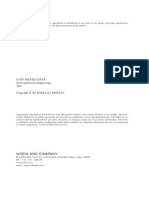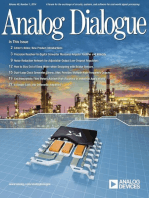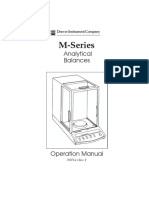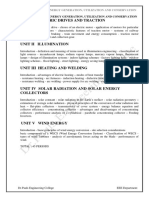0 ratings0% found this document useful (0 votes)
410 viewsAssignment 2
This document contains an assignment from a course on instrumentation and measurement. It includes 9 questions related to calibrating and using first-order instruments to measure signals of various frequencies and periodic waveforms. The questions address topics like estimating time constants, dynamic errors, acceptable measurement frequencies based on tolerable error ranges, and selecting suitable transducers to measure signals within specified error tolerances.
Uploaded by
EmtiazEmonCopyright
© © All Rights Reserved
Available Formats
Download as PDF, TXT or read online on Scribd
0 ratings0% found this document useful (0 votes)
410 viewsAssignment 2
This document contains an assignment from a course on instrumentation and measurement. It includes 9 questions related to calibrating and using first-order instruments to measure signals of various frequencies and periodic waveforms. The questions address topics like estimating time constants, dynamic errors, acceptable measurement frequencies based on tolerable error ranges, and selecting suitable transducers to measure signals within specified error tolerances.
Uploaded by
EmtiazEmonCopyright
© © All Rights Reserved
Available Formats
Download as PDF, TXT or read online on Scribd
You are on page 1/ 2
Department of Mechanical Engineering
Military Institute of Science and Technology (MIST)
ME 361: Instrumentation and Measurement
Assignment: 2
Date of submission: March 15, 2018
1. During a step function calibration, a first-order instrument is exposed to a step
change of 100 units. If after 1.2 se= the instrument indicate 80 units, estimate the
instrument time constant. Estimate the error in the indicated value after 1.5 s,
y(0)=0 units and K=1 unit/unit..
2. Estimate any dynamic error that could result from measuring a 2 Hz periodic
waveform using a first-order system having a time constant of 0.7 s.
3. A signal expected to be of the form F(t)=10 sin 15.7t is to be measured with a
first-order instrument having a time constant of 50 ms. Write the expected
indicated steady response output signal. Is this instrument a good choice for this
measurement? What is the expected time lag between input and output signal?
Plot the output amplitude spectrum y(0)=0 and K=1 V/V
4. A first-order instrument with a time constant of 2 s is to be used to measure a
periodic input. If a dynamic error of ±2% can be tolerated, determine the
maximum frequency of periodic input that can be measured. What is the
associated time lag (in seconds) at this frequency?
5. A single-loop LR circuit having a resistance of 1 M is to be used as a low-pass
filter between an input signal and a voltage measurement device. To attenuate
undesirable frequencies above 1000 Hz by at least 50%, select a suitable inductor
size. The time constant for this circuit is given by L/R.
6. A step test of a transducer brings on a damped oscillation decaying to a steady
value. If the period of oscillation is 0.577 ms, what is the transducer ringing
frequency?
7. An application demands that a sinusoidal pressure variation of 250 Hz be
measured with no more than 2% dynamic error. In selecting a suitable pressure
transducer from a vendor catalog, you note that a desirable line of transducers
has a fixed natural frequency of 600 Hz but that you have a choice of transducer
damping ratios of between 0.5 and 1.5 mm increments of 0.05. Select a suitable
transducer.
Prepared by Dr. Md. Shahnewaz Bhuiyan
March 11, 2018
8. A single-loop RCL electrical circuit can be modeled as a second-order system in
terms of current. Show that the differential equation for such a circuit subjected
to a forcing function potential E(t) is given by
𝑑2𝐼 𝑑𝐼 𝐼
𝐿 2 + 𝑅 + = 𝐸(𝑡)
𝑑𝑡 𝑑𝑡 𝐶
Determine the natural frequency and damping ratio for this system. For a forcing
potential, E(t)=1+0.5 sin 2000t, determine the system steady response when L=2
H, C=1 F, and R=10000 o. Plot the steady output signal and input singnal versus
time, I(0)= Í(0)=0
9. A force transducer having a damping ratio of 0.5 and a natural frequency of
4000 Hz is available for use to measure a periodic signal of 2000 Hz. Show
whether or not the transducer passes a ±10% dynamic error constraint. Estimate
its resonance frequency.
Prepared by Dr. Md. Shahnewaz Bhuiyan
March 11, 2018
You might also like
- Practice Problems For Instrumentation and MeasurementNo ratings yetPractice Problems For Instrumentation and Measurement13 pages
- Does A Smaller Diameter Thermocouple or A Larger Diameter Thermocouple Have The Large Time ConstantNo ratings yetDoes A Smaller Diameter Thermocouple or A Larger Diameter Thermocouple Have The Large Time Constant2 pages
- Instrumentation and Measurement (Meng3204) - Assignment 1: Dynamic Response of Measurement SystemNo ratings yetInstrumentation and Measurement (Meng3204) - Assignment 1: Dynamic Response of Measurement System1 page
- Instrumentation and Measurement (Meng3204) - Assignment 1: Dynamic Response of Measurement SystemNo ratings yetInstrumentation and Measurement (Meng3204) - Assignment 1: Dynamic Response of Measurement System1 page
- MTExam1 Engineering Metrology & Measurements 2022 2023No ratings yetMTExam1 Engineering Metrology & Measurements 2022 20235 pages
- Test Paper:6 Paper Type: Whole Testpaper Test Date: 26 December 2010 Test Location: Chennai Posted By: SanjayNo ratings yetTest Paper:6 Paper Type: Whole Testpaper Test Date: 26 December 2010 Test Location: Chennai Posted By: Sanjay9 pages
- IES OBJ Electrical Engineering 2001 Paper INo ratings yetIES OBJ Electrical Engineering 2001 Paper I15 pages
- Ch-4 Dynamic Characteristics of InstrumentsNo ratings yetCh-4 Dynamic Characteristics of Instruments52 pages
- BME 530 (1) - Basic Concepts of Medical InstrumentationNo ratings yetBME 530 (1) - Basic Concepts of Medical Instrumentation29 pages
- Industrial Instrumentation: Chapter 2: Instrument Types and Performance Characteristics-Part 2No ratings yetIndustrial Instrumentation: Chapter 2: Instrument Types and Performance Characteristics-Part 29 pages
- MTExam1 Engineering Metrology & Measurements 2022 2023No ratings yetMTExam1 Engineering Metrology & Measurements 2022 20235 pages
- Industrial Instrumentation: Chapter 2: Instrument Types and Performance Characteristics-Part 2No ratings yetIndustrial Instrumentation: Chapter 2: Instrument Types and Performance Characteristics-Part 210 pages
- PART-A (30 Marks) Time: 60 Minutes Solve The Following QuestionsNo ratings yetPART-A (30 Marks) Time: 60 Minutes Solve The Following Questions3 pages
- Nodia and Company: Gate Solved Paper Instrumentation Engineering 2003No ratings yetNodia and Company: Gate Solved Paper Instrumentation Engineering 200321 pages
- EEE312 Measurments and Instrumentation - END - Exam PaperNo ratings yetEEE312 Measurments and Instrumentation - END - Exam Paper5 pages
- In: Instrumentation Engineering: Q.1 To Q.20 Carry 1 Mark Each100% (2)In: Instrumentation Engineering: Q.1 To Q.20 Carry 1 Mark Each12 pages
- Instrumentation and Product Testing: Dynamic Characteristics of Measurement SystemNo ratings yetInstrumentation and Product Testing: Dynamic Characteristics of Measurement System25 pages
- Dynamic Response of Instrument Systems: Appendix FNo ratings yetDynamic Response of Instrument Systems: Appendix F10 pages
- EE 370 Electronic Instrument Assignment 2: R R R E GR e G D e R E R GNo ratings yetEE 370 Electronic Instrument Assignment 2: R R R E GR e G D e R E R G2 pages
- Material Science Fall 2016 Exam 1 SolutionNo ratings yetMaterial Science Fall 2016 Exam 1 Solution9 pages
- Principles of Instrumentation and Measurement Year 1 Sem 2No ratings yetPrinciples of Instrumentation and Measurement Year 1 Sem 28 pages
- Step Response For The Transfer Function of A Sensor PDFNo ratings yetStep Response For The Transfer Function of A Sensor PDF22 pages
- AE 242 Aerospace Measurements LaboratoryNo ratings yetAE 242 Aerospace Measurements Laboratory29 pages
- Fundamentals of Electronics 3: Discrete-time Signals and Systems, and Quantized Level SystemsFrom EverandFundamentals of Electronics 3: Discrete-time Signals and Systems, and Quantized Level SystemsNo ratings yet
- Tech Talk Tech Talk: Earthing ... What Is It?No ratings yetTech Talk Tech Talk: Earthing ... What Is It?1 page
- HXC-FB80: Three 2/3-Inch Exmor ™ CMOS Sensor HD Colour Studio CameraNo ratings yetHXC-FB80: Three 2/3-Inch Exmor ™ CMOS Sensor HD Colour Studio Camera10 pages
- Denver Inst Analytical Balances M-Series Operation ManualNo ratings yetDenver Inst Analytical Balances M-Series Operation Manual29 pages
- Chapter 17 The Telephone Circuit Tomasi Review PDFNo ratings yetChapter 17 The Telephone Circuit Tomasi Review PDF9 pages
- 2-Dimensional Beam Scanning Gap Waveguide Leaky Wave Antenna Array Based On Butler Matrix in Metallic 3D Printed TechnologyNo ratings yet2-Dimensional Beam Scanning Gap Waveguide Leaky Wave Antenna Array Based On Butler Matrix in Metallic 3D Printed Technology4 pages
- TV - LAPTOP - PHONE - Haier Fault Code Trascoding - EN - v3No ratings yetTV - LAPTOP - PHONE - Haier Fault Code Trascoding - EN - v36 pages
- Lab Exercise On Full Wave and Half Wave SCR Rectifiers100% (1)Lab Exercise On Full Wave and Half Wave SCR Rectifiers5 pages
- Product Datasheet: APC Smart-UPS C 2000VA LCD 230VNo ratings yetProduct Datasheet: APC Smart-UPS C 2000VA LCD 230V3 pages
- Physics Class 12 Project by Ramann ChawlaNo ratings yetPhysics Class 12 Project by Ramann Chawla6 pages
- Hi-Tech Institute of Engineering and Technology, GhaziabadNo ratings yetHi-Tech Institute of Engineering and Technology, Ghaziabad1 page
- Comparative Study of Sense Amplifiers For Sram IJERTCONV4IS32019No ratings yetComparative Study of Sense Amplifiers For Sram IJERTCONV4IS320194 pages
- JBL Cinema Sb150: Home Cinema 2.1 Soundbar With Wireless SubwooferNo ratings yetJBL Cinema Sb150: Home Cinema 2.1 Soundbar With Wireless Subwoofer9 pages

























































































